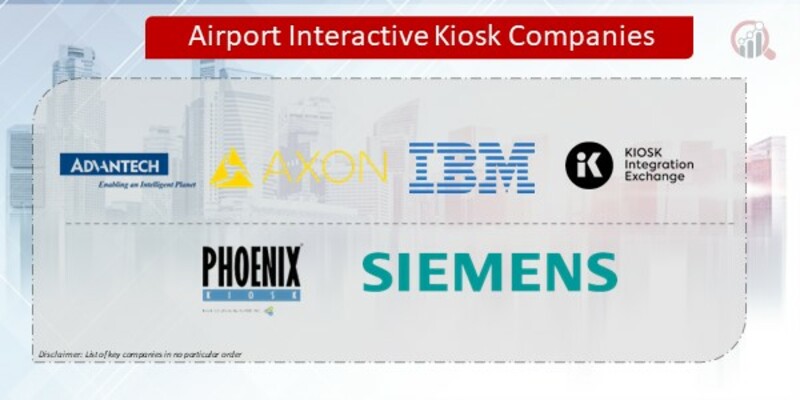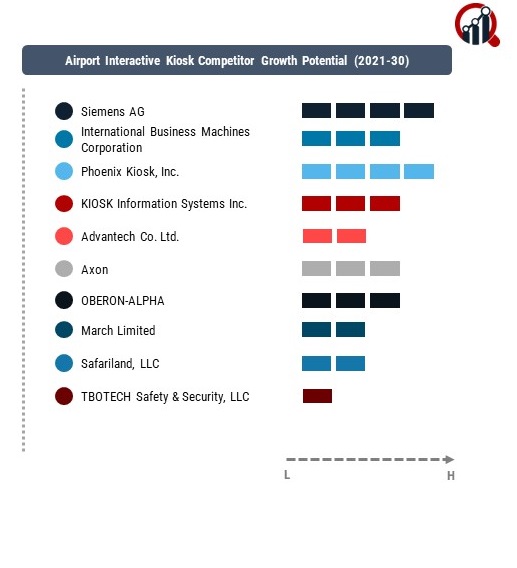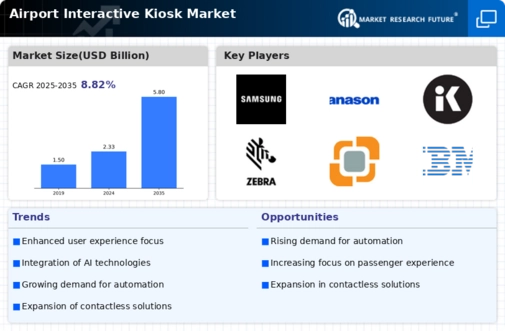Top Industry Leaders in the Airport Interactive Kiosk Market

Strategies Adopted: In the fiercely competitive Airport Interactive Kiosk market, key players employ strategic approaches to maintain a competitive edge. Continuous investment in research and development (R&D) is pivotal, allowing companies to introduce next-generation kiosks with enhanced functionality, intuitive interfaces, and seamless integration with airport systems. Strategic collaborations with airports, airlines, and technology partners facilitate the development of specialized kiosk solutions tailored to specific airport requirements. Global market expansion is achieved through participation in airport modernization projects, international installations, and establishing partnerships with key stakeholders, ensuring a broad market reach and allowing companies to address the diverse needs of airports worldwide.
Competitive Landscape of Airport Interactive Kiosk Market
- Siemens AG (German)
- International Business Machines Corporation (U.S)
- Phoenix Kiosk Inc. (U.S)
- KIOSK Information Systems Inc. (U.S) Advantech Co. Ltd. (Taiwan)
- Axon (U.S.)
- OBERON-ALPHA (Russia)
- March Limited (Bermuda)
- Safariland LLC (U.S.)
- TBOTECH Safety & Security LLC (U.S.)
Factors for Market Share Analysis: Market share analysis in the Airport Interactive Kiosk market involves considering various factors crucial to a company's competitive standing. Technical capabilities, such as offering a comprehensive range of kiosk solutions covering check-in, baggage handling, wayfinding, and information services, play a pivotal role. Companies providing adaptable and customizable kiosks capable of addressing diverse airport functionalities are better positioned to capture a larger market share. Compliance with stringent aviation standards, reliability, user-friendly interfaces, and integration of advanced technologies such as biometrics contribute significantly to market share dynamics. Additionally, factors like maintenance services, scalability, and cost-effectiveness influence a company's market share by enhancing the overall value proposition for airports seeking self-service solutions.
New and Emerging Companies: While established players dominate the market, new and emerging companies are making strides in the Airport Interactive Kiosk sector. Companies like Elenium Automation and ZKTeco are gaining recognition for their specialized kiosk solutions, often focusing on innovative features, touchless technologies, and data analytics capabilities. Emerging companies often bring agility and a fresh perspective to the Airport Interactive Kiosk market, introducing novel approaches and technologies that address the evolving needs of modern airports and passengers.
Industry News: Recent industry news in the Airport Interactive Kiosk market underscores ongoing developments and trends shaping the sector. Innovations in touchless kiosk interfaces, biometric authentication for seamless passenger identification, and artificial intelligence applications for personalized services are gaining prominence. News often covers advancements in kiosk connectivity, enabling real-time data exchange with airport systems and facilitating a more streamlined passenger journey. Additionally, developments in incorporating sustainability features, such as energy-efficient designs and the use of recyclable materials, highlight the industry's commitment to environmental responsibility. Industry news reflects the dynamic nature of the Airport Interactive Kiosk market, with continuous efforts to improve passenger experience, operational efficiency, and overall airport functionality.
Current Company Investment Trends: Investment trends in the Airport Interactive Kiosk market underscore a commitment to technological innovation, connectivity, and global reach. Companies are allocating substantial resources to R&D initiatives focused on touchless technologies, artificial intelligence applications, and the integration of biometrics for enhanced security and efficiency. Investments in data analytics capabilities, enabling airports to derive insights from kiosk usage patterns, align with the industry's broader push towards data-driven decision-making. Strategic acquisitions of technology startups, partnerships with airport authorities, and collaborations with aviation technology providers contribute to a comprehensive approach, ensuring a continuous stream of cutting-edge solutions and maintaining a competitive stance in the market.
Overall Competitive Scenario: The overall competitive scenario in the Airport Interactive Kiosk market reflects a balance between established industry leaders and emerging companies that bring innovation and flexibility to the sector. Established providers of aviation technology leverage their extensive experience, global reach, and comprehensive interactive kiosk portfolios to set industry standards. Simultaneously, emerging companies contribute to the diversification of Airport Interactive Kiosk solutions, often focusing on specific applications or introducing disruptive technologies. The industry's response to evolving airport requirements, technological advancements, and the integration of advanced features into interactive kiosks highlights the adaptability and resilience of Airport Interactive Kiosk providers. As airports globally seek more advanced and passenger-friendly self-service solutions, the Airport Interactive Kiosk market is poised for continued evolution. The emphasis on technological advancements, strategic collaborations, and meeting the dynamic needs of modern air travel positions this market as a critical enabler for enhancing the overall passenger experience and optimizing airport operations.
Recent Development:
In January 2021, Diebold Nixdorf introduced the DN Series EASY, a new suite of self-service solutions designed to address retailers' critical needs. These solutions aim to enhance store efficiency, elevate the consumer shopping experience, and reduce operational costs.
In October 2020, Meridian unveiled temperature screening kiosks that provide a completely touchless temperature checking experience. Individuals scan one at a time by positioning their face within the designated frame on the kiosk screen. A thermal sensor then reads their temperatures, displaying the results on-screen for user verification. The process is simple, with accuracy within ± 0.9°F, and remarkably swift, completing the entire temperature screening in approximately 2 seconds per person.










